
The Lake Wales Ridge National Wildlife Refuge is part of the United States National Wildlife Refuge (NWR) System, located in four separated areas on the Lake Wales Ridge east of US 27 between Davenport and Sebring Florida. The 1,194 acre (4.8 km2) refuge was established in 1990, to protect a host of plants and animals. It is also the first to be designated primarily for the preservation of endangered plants, and is not open to the general public. It contains a high proportion of remaining Florida scrub habitat. It is administered as part of the Merritt Island National Wildlife Refuge.

Paronychia is a genus of plants in the family Caryophyllaceae with over 110 species worldwide, mostly from warm-temperate North America, Eurasia, South America and Africa. They are herbs that are annual or biennial or perennial in life span. Some species have a woody base. For the most part they have small, white to yellow-white colored flowers that are often hidden within the paired bracts.

Erysimum menziesii is a species of Erysimum known by the common name Menzies' wallflower.
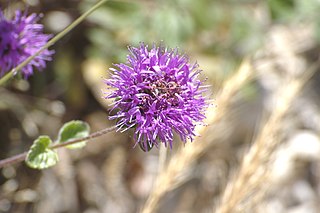
Monardella undulata is an uncommon species of flowering plant in the mint family known by the common name curlyleaf monardella. It is an annual herb and is endemic to the coast of California.

Paronychia ahartii is a species of flowering plant in the family Caryophyllaceae known by the common name Ahart's nailwort. It is endemic to California, where it is known from three counties at the northern edge of the Sacramento Valley where it rises into the southern slopes of the Cascade Range. It is a plant of moist, rocky habitat, such as vernal pools. This is a petite plant producing a nearly invisible stem from a threadlike taproot. The plant is only about a centimeter wide and somewhat spherical in shape. It is a tiny patch of bristle-tipped green leaves a few millimeters in length with oval-shaped stipules. The single flower occurring in each leaf axil has no petals but white, rough-textured, awn-tipped sepals clustered around the leaves.

Stellaria longipes is a species of flowering plant in the family Caryophyllaceae known by the common names longstalk starwort and Goldie's starwort. It has a circumpolar distribution, occurring throughout the northernmost latitudes of the Northern Hemisphere. It is a perennial herb that grows in a wide variety of habitat types, including tundra and taiga and many areas farther south with subalpine and alpine climates. It is extremely variable in morphology, its form depending on both genetic makeup and environmental conditions. It has a widely varying number of chromosomes. In general, it is a rhizomatous perennial herb forming mats or clumps, or growing erect. The stems may be short and simple or with sprawling and highly branched. The linear to lance-shaped leaves are usually 1 to 4 centimeters long and are oppositely arranged in pairs. The inflorescence bears one or more flowers, each on a short pedicel. The flower has five pointed green sepals each a few millimeters long. There are five white petals each divided into two lobes, sometimes shallowly, but often so deeply there appear to be two petals. The plant is gynodioecious, with some flowers having functional male and female reproductive parts and others being only female.

Bonamia grandiflora is a rare species of flowering plant in the morning glory family known by the common names Florida lady's nightcap, Florida bonamia, and scrub morning glory. It is endemic to Central Florida, where there are about 100 known populations remaining, many of which are within the bounds of the Ocala National Forest. The plant has declined in recent decades primarily due to the development of its habitat, which is being converted to urban zones and citrus groves. This is the primary reason that the plant was federally listed as a threatened species in 1987.

Chrysopsis floridana is a rare species of flowering plant in the family Asteraceae, known by its common name, Florida golden aster. It is endemic to Florida in the United States, where it is known from Hillsborough, Hardee, Manatee, and Pinellas Counties. It is considered an endemic of the west-central coast of the state in the general vicinity of Tampa Bay. There are 17 to 20 occurrences, many of which have few individuals, but one of which has over one million plants. In 1986 the plant was added to the US endangered species list because it was becoming increasingly rare, it was growing only on private property, and its habitat was unprotected and being destroyed and degraded by a number of forces. It is found at Bell Creek Nature Preserve in Riverview, Florida.

Clitoria fragrans is a rare species of flowering plant in the legume family known by the common name pigeon wings, or sweet-scented pigeon wings. It is endemic to Central Florida, where it was known most recently from 62 occurrences, but no current estimates of the total global population are available. The plant is a federally listed threatened species of the United States.
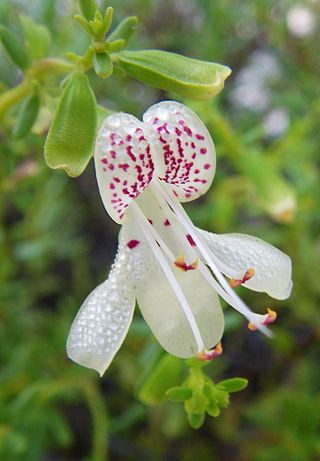
Dicerandra christmanii is a rare species of flowering plant in the mint family known by the common names Garrett's mint, yellow scrub balm, and Lake Wales balm. It is endemic to Highlands County, Florida, in the United States, where it is known from only four sites on the Lake Wales Ridge. All are contained within a tract of land measuring 6 kilometers by 3 kilometers. The plant is steadily declining due to the destruction and degradation of its habitat, and only one of the four occurrences is on protected land. It is a federally listed endangered species.
Dicerandra cornutissima is a rare species of flowering plant in the mint family known by the common name longspurred mint, longspurred balm, and Robin's mint. It is endemic to Florida in the United States. It is found in Marion County, and possibly Sumter County, but it may have been totally extirpated from the latter. There are 15 known occurrences remaining. The plant was federally listed as an endangered species in 1985.
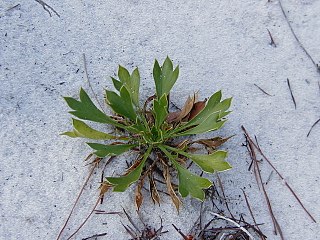
Eryngium cuneifolium is a rare species of flowering plant in the carrot family known by the common names wedgeleaf eryngo, wedge-leaved button-snakeroot, and simply snakeroot. It is endemic to the state of Florida in the United States where it is known only from Highlands County. It is one of many rare species that can be found only on the Lake Wales Ridge, an area of high endemism. It was federally listed as an endangered species of the United States in 1987.
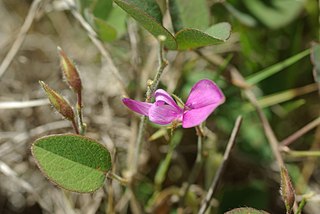
Galactia smallii is a rare species of flowering plant in the legume family known by the common name Small's milkpea. It is endemic to Florida, where it is known only from a few small patches of remaining habitat in Miami-Dade County. It is threatened by the destruction and inadequate management of its habitat. It was federally listed as an endangered species of the United States in 1985.

Hypericum cumulicola is a rare species of flowering plant in the family Hypericaceae known by the common name highlands scrub hypericum, or highlands scrub St. John's wort. It is endemic to Florida, where it is threatened by habitat loss and degradation. It is a federally listed endangered species of the United States.
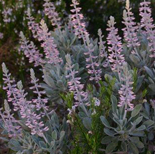
Lupinus aridorum is a rare species of lupine known by the common name scrub lupine. It is endemic to Florida in the United States, where there were 10 known populations remaining in 2003. Fewer than 6000 individual plants were counted. It is threatened by the loss and degradation of its habitat. The scrub lupine is a federally listed endangered species of the United States.

Lysimachia asperulifolia is a rare species of flowering plant in the Primulaceae known by the common name rough-leaved loosestrife and roughleaf yellow loosestrife. It is endemic to the Atlantic coastal plain in North Carolina and northern South Carolina in the United States, where there are 64 known populations. It is a federally listed endangered species of the United States.
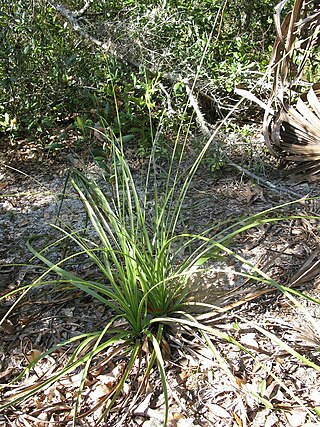
Nolina brittoniana is a rare species of flowering plant in the asparagus family known by the common name Britton's beargrass. It is endemic to Florida, where there are 72 known populations, only a few of which are large enough to be considered viable. It is federally listed as an endangered species of the United States.

Polygala lewtonii is a rare species of flowering plant in the milkwort family known by the common name Lewton's polygala, or Lewton's milkwort. It is endemic to Florida in the United States, where it is limited to the central ridge of the peninsula. There are about 49 occurrences of the plant remaining. Most occurrences contain very few plants. The species is threatened by the loss and degradation of its habitat. This is a federally listed endangered species of the United States.
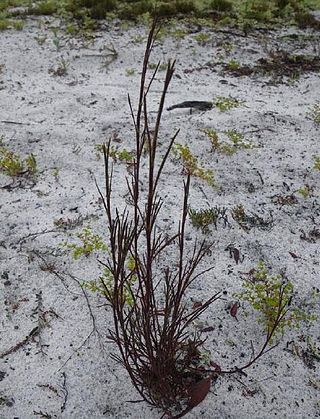
Polygonum basiramia is a rare species of flowering plant in the knotweed family known by the common names wireweed, hairy wireweed, purple wireweed, and Florida jointweed. It is endemic to Florida in the United States, where it is limited to the central ridges of the peninsula, including the Lake Wales Ridge. It is threatened by the loss and degradation of its habitat. It is a federally listed endangered species of the United States.
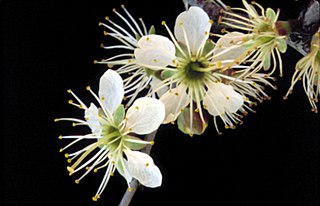
Prunus geniculata is a rare species of plum known by the common name scrub plum. The species is endemic to Florida.




















